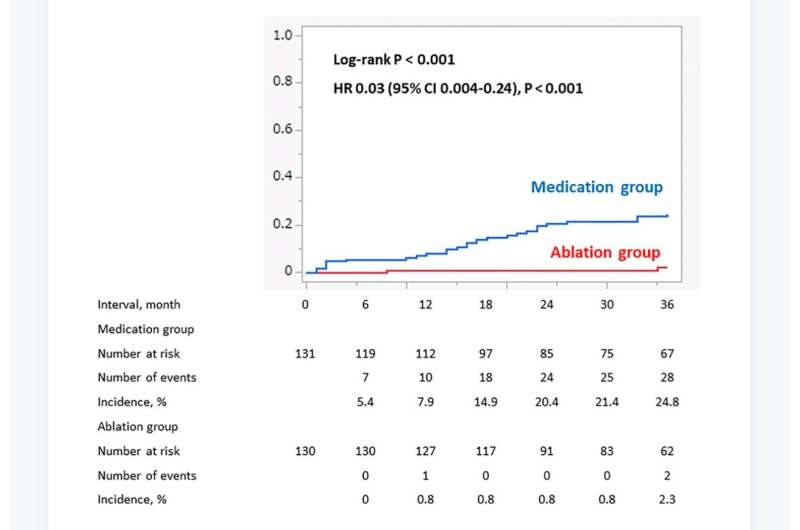This article has been reviewed according to Science X's editorial process and policies. Editors have highlighted the following attributes while ensuring the content's credibility:
fact-checked
proofread
Catheter ablation in very old patients with nonvalvular atrial fibrillation

A new research paper titled "Cardiovascular events and death after catheter ablation in very old patients with nonvalvular atrial fibrillation" has been published inAging.
Catheter ablation of atrial fibrillation (AF) is recommended for selected older patients. However, the preventive effects of AF ablation on cardiovascular events and death remain unclear, especially in older patients. In this new study, researchers Keisuke Okawa, Satoshi Taya, Takeshi Morimoto, Ryu Tsushima, Yuya Sudo, Ai Sakamoto, Eisuke Saito, Masahiro Sogo, Masatomo Ozaki, and Masahiko Takahashi from Kagawa Prefectural Central Hospital and Hyogo Medical University have aimed to investigate the impact of AF ablation on the incidence of cardiovascular events and death in very old nonvalvular AF (NVAF) patients.
The researchers explain, "We conducted a prospective cohort study of consecutive patients with NVAF aged ≥80 years and using direct oral anticoagulants (DOACs)."
The researchers defined cardiovascular events as acute heart failure (AHF), strokes and systemic embolisms (SSEs), acute coronary syndrome (ACS), and sudden cardiac death (SCD) and cardiovascular death as AHF/SSE/ACS-related death and SCD. They compared the 3-year incidence of cardiovascular events and death between the patients who underwent AF ablation (Ablation group) and those who received medical therapy only (medication group).
Among the 782 NVAF patients using DOACs, propensity score matching provided 208 patients in each group. The ablation group had a significantly lower 3-year incidence of cardiovascular events and death than the medication group: cardiovascular events, 24 (13.2%) vs. 43 (23.3%), log-rank P = 0.009 and hazard ratio (HR) 0.52 (95% confidence interval (CI) 0.32–0.86) and cardiovascular deaths, 5 (3.0%) vs. 15 (7.8%), log-rank P = 0.019 and HR 0.32 (95% CI 0.16–0.88).
"In very old NVAF patients using DOACs, those who underwent AF ablation had a lower incidence of both cardiovascular events and death than those who received medical therapy only," the research team concludes.
More information: Keisuke Okawa et al, Cardiovascular events and death after catheter ablation in very old patients with nonvalvular atrial fibrillation, Aging (2023). DOI: 10.18632/aging.204952





















